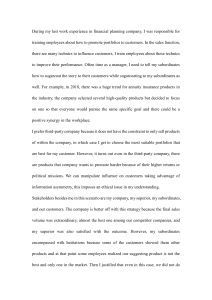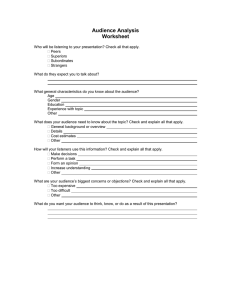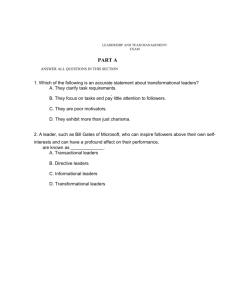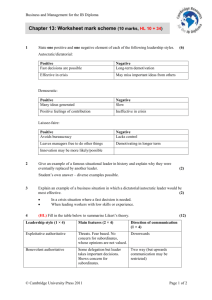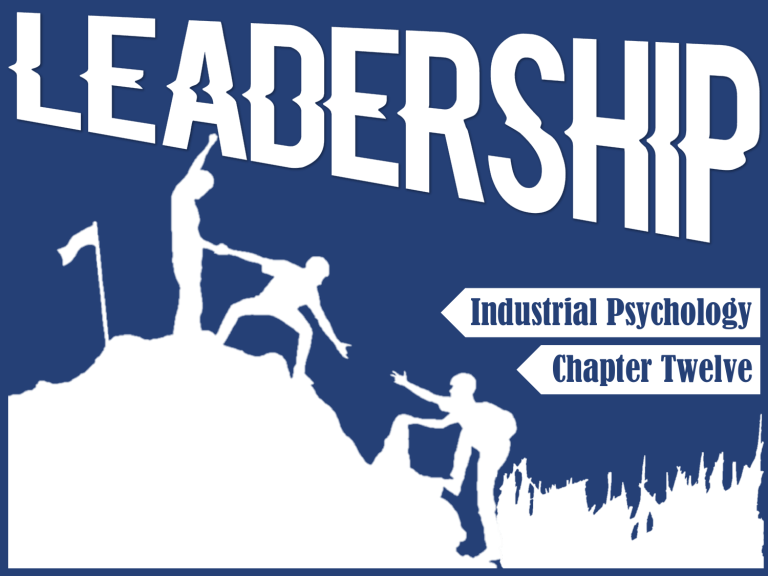
Industrial Psychology Chapter Twelve QUESTIONS • How much of the organization’s performance can be attributed to the leader? • If the leader was the major cause of the changes in performance, why was one leader successful and the other a failure? ARE LEADERS personal traits needs orientation specific skills behaviors Personal Characteristics Associated with Leadership Personal Characteristics Associated with Leadership • Leader Emergence - possess traits or characteristics different from people who do not become leaders • Leader Performance – leaders who perform well possess certain characteristics that poorly performing leaders do not LEADER PERFORMANCE Research on the relationship between personal characteristics and leader performance has concentrated on three areas: TRAITS NEEDS COGNITIVE ABILITY LEADER PERFORMANCE Research on the relationship between personal characteristics and leader performance has concentrated on three areas: GENDER TASK VS. PERSON ORIENTATION UNSUCCESSFUL LEADERS TASK VS. PERSON TASK PERSON Define and structure their own roles and those of their subordinates to attain the group’s formal goals Act in warm and supportive manner and show concern for subordinates See their employees as lazy, extrinsically motivated, wanting security, undisciplined and shrinking responsibility Believe that employees are intrinsically motivated Leads through giving directives, setting goals, and making decisions without consulting subordinates Seek responsibility Tend to produce humor Tend to appreciate humor Should have productive employees Should have satisfied employees Self-controlled Do not necessarily dislike work Tend to become socially withdrawn when under pressure UNSUCCESSFUL LEADERS • Lack of Training • Cognitive Deficiencies • Personality - Paranoid - High-Likability Floater - Narcissist Interaction between Leader and Situation SITUATIONAL NATURE OF LEADERSHIP: THEORIES •Situational Favorability •Organizational Climate •Subordinate Ability •Relationships with Subordinate SITUATIONAL FAVORABILITY - best-known and most controversial situational theory - developed by Fred Fiedler in the mid-1960s - an individual’s leadership style is the result of a lifetime of experiences and thus is extremely difficult to change FIEDLER’S CONTINGENCY MODEL - holds that any individual’s leadership style is effective only in certain situations ORGANIZATIONAL CLIMATE I M P A C T - informational - magnetic - position - affiliation - coercive - tactical ORGANIZATIONAL CLIMATE: Informational Style in a Climate of Ignorance - provides information in a climate of ignorance, where important information is missing from the group Magnetic Style in a Climate of Despair - leads through energy and optimism and is effective only in a climate of despair, which is characterized by low morale Position Style in a Climate of Instability - leads by virtue of the power inherent in that position Affiliation Style in a Climate of Anxiety - leads by liking and caring about others Coercive Style in a Climate of Crisis - leads by controlling reward and punishment and is most effective in a climate of crisis. Tactical Style in a Climate of Disorganization - leads through the use of strategy and is most effective in a climate of disorganization Path-Goal Theory - states that a leader can adopt one of four behavioral leadership styles to handle each situation: instrumental, supportive, participative, or achievement-oriented Instrumental – planning, organizing, and controlling the activities of employees Supportive – leader shows concern for employees Participative – leader shares information with employees and lets them participate in decision making Achievement-oriented – leader sets challenging goals and rewards increases in performance Situational Leadership Theory - developed by Hersey and Blanchard - a leader typically uses one of four behavioral styles: delegating, directing, supporting, or coaching follower readiness - the ability and willingness to perform a particular task Situational Leadership Theory Directing –the leader directs the follower by telling him what to do and how to do it Coaching – leaders using this approach explain and clarify how work should be done Supporting - Able but unwilling or insecure Delegating - Able and willing or confident Specific Leader Skills • According to Yukl, Carter, Hemphill and Coons, and Gibbs leaders do the following: • Communicate formally • Initiate ideas with subordinates • Informally interact • Reward and punish with subordinates subordinates • Set goals • Stand up for and support subordinates • Make decisions • Train and develop • Take responsibility employee skills • Develop a group • Solve problems atmosphere • Generate enthusiasm • Organize and structure work Specific Leader Skills • Decision Making - decisions are best made with the participation of a leader’s subordinates, colleagues, or both. • Contact: Management by Walking Around - increase communication, build relationships with employees, and encourage employee participation • Power - important to a leader because as it increases so does the leader’s potential to influence others Basic Types of Power • Expert Power - leaders who know something useful—that is, have expert knowledge—will have power • Legitimate Power - obtained on the basis of one’s position • Reward and Coercive Power - power to the extent that they can reward and punish others • Referent Power - Complimenting others, doing favors, and generally being friendly and supportive Specific Leader Skills • Vision 1. Transactional Leadership - thought to have three dimensions: contingent reward, management by exception–active, and management by exception–passive 2. Transformational Leadership - focuses on changing or transforming the goals, values, ethics, standards, and performance of others • Persuasion Persuasion by Communication - people who have certain characteristics can communicate through persuasion more easily than people who lack these characteristics Cultural Differences in Leadership Project GLOBE researchers have concluded that cultures can differ on these nine dimensions: 1. Uncertainty avoidance: The extent to which a culture avoids 2. Power distance: The extent to which power is unequally 3. Social collectivism: The extent to which a culture uncertainty by using social norms and rituals shared encourages collective distribution of resources 4. In-group collectivism: The extent to which individuals express pride in their organizations and families 5. Gender egalitarianism: The extent to which a culture tries to minimize differences in gender roles and prevent discrimination Cultural Differences in Leadership 6. Assertiveness: The extent to which individuals in a culture are assertive and challenging in social relationships 7. Future orientation: The extent to which a culture plans for and invests in the future 8. Performance orientation: The extent to which a culture encourages and rewards improvement in performance 9. Humane orientation: The extent to which a culture encourages and rewards people for being fair, caring, and giving Thank you!

